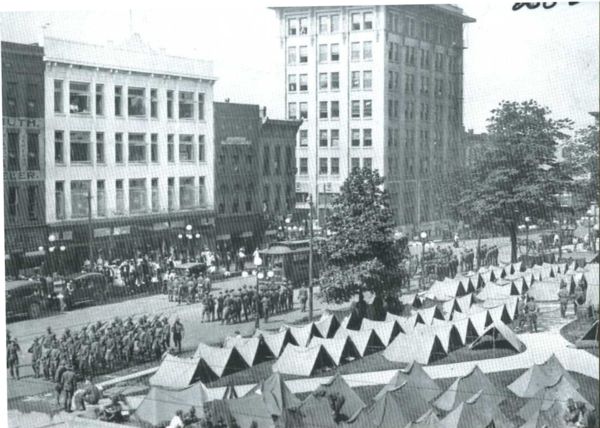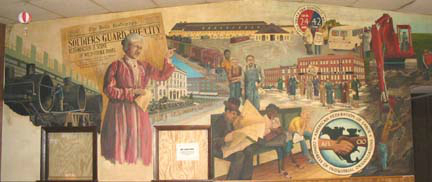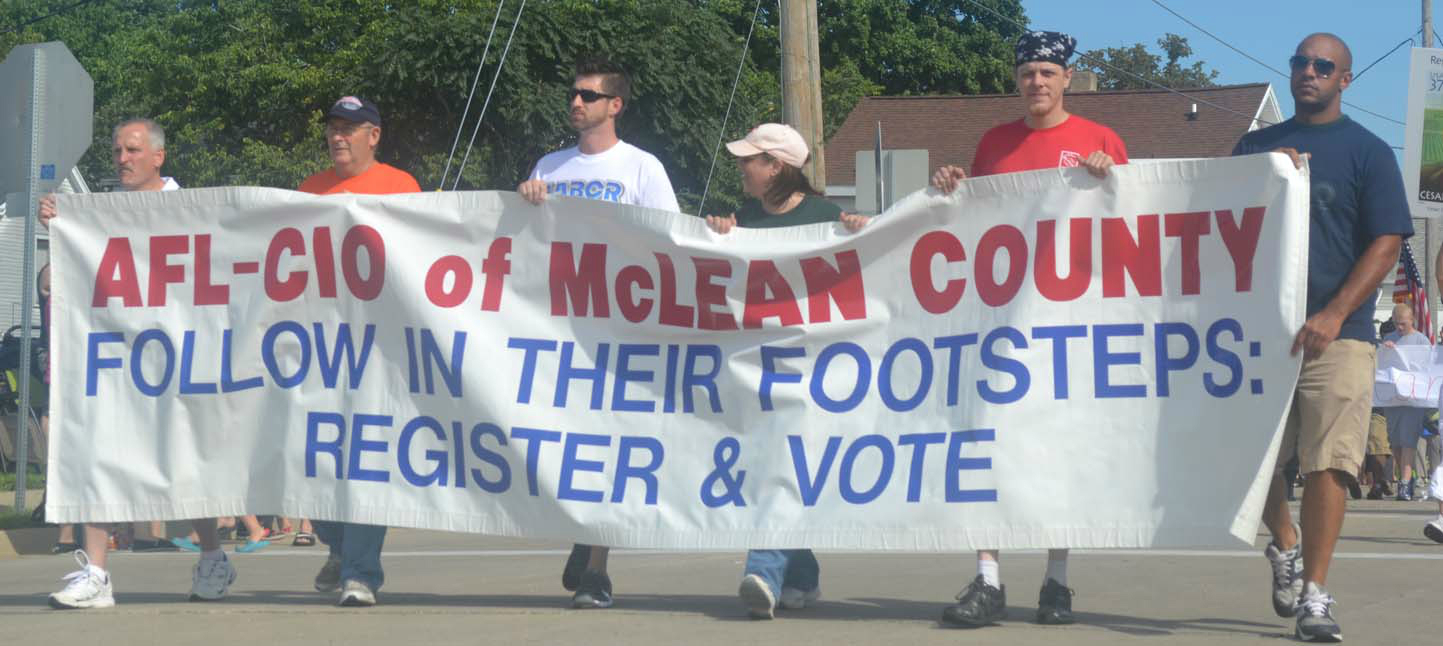
|
| National Guard troops surround the McLean County Courthouse in downtown Bloomington, July 6, 1917, after a fiery speech by Mary "Mother" Jones. McLean Co Historical Society photo. |
|
Although unsuccessful at the polls, Bloomington labor could still point to other accomplishments. In 1917, after an almost 20 years of effort, streetcar workers successfully formed Local 752 of the Amalgamated Association of Street and Electric Railway Workers.
Bloomington had its wildest labor night on July 5, 1917, with famed labor organizer Mary “Mother Jones” (1837-1930) stoking striking transit workers. A night of mayhem brought 1,400 National Guard troops to town, but also won a contract for Amalgamated Transit Union Local 752.
Before the automotive age, people walked to work or rode electric trolleys or streetcars. The Bloomington & Normal Street Railway (B&N), which began as a horse-drawn railway in 1867, carried passengers on 26 route miles through Bloomington & Normal. Transit workers had formed a union in 1902, lost in after a six-month strike in 1904, and came back in 1917 to organize again.
In 1917, the B&N was owned by U.S. Congressman William McKinley (1856-1926). McKinley controlled the streetcar systems in Champaign, Peoria, Galesburg and Danville, along with the Illinois Traction System, an electric interurban railroad that connected St. Louis with Peoria, Danville, Springfield, Champaign, Decatur and Bloomington. Thanks to its electric generating capacity, this eventually became the Illinois Power Company, today’s Ameren.
Although the streetcar system meant a modern city a century ago, it was tough on workers.
David Law (1852-1916) began work on the horse cars, standing on an open platform, exposed to the weather, for a fifteen-and-a-half-hour day. He said, “I have stood on this platform with the thermometer twenty-four to thirty degrees below zero, and I have made my way through mountainous snow drifts, and when the rails were a glare of ice, as well as through beating rains and burning suns. No, we haven’t a soft job and we literally earn our bread by the sweat of our brow.” The transit workers labored seven days a week for $50 per month. To get a day off, they pooled their funds so they could buy a replacement for one day off per month. Law noted that on that one day month off, his children asked, “who is that strange man in the house.”
By 1917, the trolley workers made $1.75 a day, for a nine-and-a-half-hour workday. On May 17, 1917, 50 workers met in a midnight mass meeting, with the assistance of Jerry Burnette from Peoria Local 416 of the Amalgamated Association of Street & Electric Railway Men. At first the company refused a pay increase, but eventually offered 20 cents per day. The workers wanted more – union recognition. The company refused. On May 28, the strike began. Half the workers, satisfied with the pay raise, stayed with the company. The workers made clear their goal – union recognition.
“The strike of the Bloomington street car employees has been called for the reason that the company denies us the right which millions of workingmen all over the United States are exercising, and have been exercising for years – the right to organize.
“We believe our cause is just and we ask for the support of the public in asserting our rights as citizens of a free country.”
The strikers, and the Bloomington Trades & Labor Assembly, both asked Mayor E.E. Jones to mediate. The company refused the mayor’s offer. The workers asked the public to boycott the cars and support the strike. The appealed to the public, saying:
“Streetcar strike is on. The employees on strike ask the support of the public in their efforts for a square deal. We believe the company has no more right to forbid the organization of labor than we have to forbid the organization of capital. But the company has discharged our members merely for joining the union. …They will concede nothing unless we go back abjectly as individuals and surrender our natural rights. Are you for a square deal?”
On Saturday night, June 9, at the company’s request, Judge Sain Welty issued a sweeping court injunction, which basically forbade almost all strike activities and public outreach. The court injunction forbade the union and its members from congregating on street corners, distributing hand bills, sending out any communication or asking people to boycott.
On June 11, a strike rally was held, with speeches by Illinois Federation of President John Walker, a coal miner, and Bloomington & Normal Trades & Labor Assembly President John Lennon. The strikers were encouraged to refrain from violence and to win the public’s approval. Walker said that a successful strike would be a “victory for all labor organizations.” That night, the streetcar company’s powerhouse workers walked out in a sympathy strike.
After a month on strike, with the streetcars running and a repressive court injunction limiting strike activity, the situation was becoming desperate. In 1902, the streetcar workers had gained a union, but lost it after a six-month strike in 1904. Would they lose again? To rally their cause, they turned to a famous worker advocate, Mary “Mother” Jones.
Jones was an Irish immigrant who came to North America as a child; she knew tragedy. She married a union iron molder named George Jones in 1861. They moved to Memphis, and had four children. In a yellow fever epidemic in 1867, she lost her husband and all her children. She moved to Chicago, opening a dress shop, which she lost in the Great Chicago Fire in 1871. By the early 1900s she was tramping across the United States, organizing coal miners, fighting against child labor, and finding herself thrown in and out of jail cells. In a West Virginia court room, she was labeled the “most dangerous woman in America.”
On July 5, 1917, she addressed a packed audience at the Eagle’s Hall, south of downtown. No one wrote her words that night, but what did survive was her final admonition, to “go out get ‘em.” Leaving the Eagle’s Hall, the excited crowd coalesced. Northbound on Main Street came a streetcar. The crowd surrounded it, beat the strikebreakers and a company guard. They first extracted the information that the strikebreakers were housed at the Phoenix and St. Nicholas hotels downtown, so that became their next destination.
As the crowd neared the Courthouse Square at Jefferson and Main, a strike breaker, Thomas Huett, fired a pistol into the crowd, hitting railroad worker Emmett Maloney. Huett was placed under arrest and spirited into the Gresheim building by the police, to protect him from the angry crowd. Then the Miller Park streetcar came around the corner and it was also attacked, with bricks thrown through the window and the strikebreakers beaten, before they were escorted away by police for their own safety.
The crowd then surged retraced their steps down Main and Madison Streets to the B&N’s electric powerhouse. The mayor, police chief and police were guarding the doors. Stones and bricks were thrown through windows. The Pantagraph reported, “Several women reported to be wives of the street car men sought to incite the men to action. With waving of arms and handkerchiefs and their shrill voices, they created much sympathy.” The situation de-escalated when the Streetcar workers’ union President, John Nitzel, told the Mayor that if the electricity would be cut off, the crowd would remain peaceful. After Nitzel and a union delegation inspected the plant with the sheriff, the power was cut. The crowd continued to demand that the company’s superintendent, Daniel W. Snyder, appear.
The mob then returned to the Courthouse Square, further vandalizing the Miller Park trolley stranded earlier and attacking the B&N Street Railway office on West Jefferson Street was then attacked. Bloomington police attempted to control the crowd, shooting their revolvers into the air and the ground. Mayor E.E. Jones pleaded with the crowd to disperse; Gene Downey, a Chicago & Alton Railroad Shops employee, challenged the mayor. Finally, the mayor agreed he would try and hold a mediation meeting the next day. With that, the crowd dispersed.
The next morning, July 6, the Mayor convened a meeting to try and mediate. Striking workers were there, along with Jerry Burnette from Peoria Local 416. Representing the strikers were union president John Nitzel, J.W. Hart, A.H. Wefer and John Farmar. With them was Jerry Burnette, representing Peoria’s local 416. Superintendent Daniel W. Snyder finally appeared. Union president John Nitzel said:
“All we want, Mr. Snyder, is fairness. We want recognition and we feel we can settle the wage question satisfactorily. Are you willing to discuss the matter?”
Snyder replied: “There is only one answer I can make and that is I cannot recognize the car men’s union.”
To which Nitzel responded, “Why can’t you recognize our union?”
“Because, some time ago we made our plans – outlined our policies and we don’t want to change our position in this matter now.”
“The McKinley interests have recognized the union at Peoria, Galesburg and other places, and why not here?”
“It is simply this; we have all the employees we need and have no reason to change. And now, gentlemen, if it’s only an issue of recognition, there is no need for further discussion.” And with that, Snyder left the room.
At 7:30 a.m. that morning, Illinois National Guard troops began arriving in Bloomington. The first contingent encamped around the power plant, with other units at the courthouse square. Eventually, 1,393 soldiers were in Bloomington, the majority encamped on the courthouse square, with machine guns at each corner.
That day at noon, when the lunch whistle blew at the Chicago & Alton Railroad Shops, then the city’s largest employer, 1,200 workers marched downtown to City Hall. They demanded a settlement. J.M. Patterson, Bloomington Trades & Labor President, and President of the Federation of Railroad Shops workers, again asked the Mayor to intervene. Mayor Jones called D.W. Snyder’s boss, the Illinois Traction System’s H.E. Chubback, and he agreed to reinstate the strikers and to an arbitration meeting the following Monday afternoon. Patterson, telling the Shops workers to return to work, said “Now men, we want to be fair. If there is any doubt in your minds as to the honesty of purpose of Mr. Chubback in this matter, let’s give him the benefit of the doubt and conduct ourselves in a peaceful and orderly manner and await developments Monday.” He also produced a telegram from B&N Railway owner Congressman William McKinley, which said, “I recognize the right of men to organize.”
The weekend was quiet; on Monday, the conference began; in attendance were Mayor Jones, as the mediator, for the company, H.E. Chubback from the Traction System, Snyder from the Street Railway, and two attorneys, Henry Creen for the Traction System and Sigmund Livingston for the street railway. On the union side were union President Nitzel, strikers J.W. Hart, John Farmar. Plus, Jerry Burnette from Peoria Local 416, three representatives from the Alton Railroad Shops unions, J.M. Patterson, R.J. Kelly and W.T. Wolcott; local attorneys Louis FitzHenry and Frank Gillespie, and American Federation of Labor Treasurer John Lennon.
After four and a half hours of negotiation, the union was recognized, the strikers reinstated to their jobs. The workers won a 35-cents a day increase and their work day was decreased from 9 and-a-half hours to mine.
With organized labor having displayed its power to a U.S. Congressman and almost winning the city government, the World War I era and its immediate aftermath seemed a time of ascendancy for organized labor in Bloomington.
In 1917 a cooperative store was established at 529 and 531 West Main Street in Bloomington. Besides selling grocery and clothing downtown, the cooperative society also ran a coal yard and a smaller store on West Chestnut Street. Louis Salch, a carpenter and one of the 1919 candidates for commissioner, headed the society.
The group's aim was more than inexpensive groceries. The cooperative store was seen as a testing ground for eventual worker control of industry:
The movement offers the opportunity for all persons so inclined to become members of a great economic movement. ...With the training secured from the co-operative movement it will be possible for the people to operate any branch of industry which they care to operate (Searchlight, 1).
The Bloomington cooperative store was the largest in Illinois through the 1920s. Seen as an alternative to capitalism, it closed during the Depression in 1935.
Three new unions also organized in this time. Five women at Kinloch Telephone Company began Telephone Operators 78A of the International Brotherhood of Electrical Workers on June 15, 1918, winning their first contract by 1921. In 1921 the women wrote to the Official Journal of the Telephone Operators Department, that "the operators were working for small wages, the girls would come and go, the service became poor so some of the girls decided that to organize a union would help (Roberts, 3)." The local remained through the 1950s, one of the last independent phone operators locals in the nation. Geraldine McKeon, one of the union's activists, served as a Trades and Labor Assembly trustee for over 30 years, often the only female office.
Bloomington's telephone operators organized a small but effective female-led union. Here is the phone company's float in the 1930 McLean County Centennial Parade, featuring the phone operators. (McLean County Historical Society)
Bloomington's city fire fighters organized as a federal labor union in 1917. Federal Labor Union was the designation for workers' organizations which had no national organization. They were directly affiliated with the AFL. In 1918 they were a charter local of the International Association of Fire Fighters. Hod Carriers, Building and Common Laborers of America Local 362, which later became Laborers International Local 362, was organized on March 25, 1919 in the building trades.
A union support organization was chartered in 1916. Local 341 of the Women's International Union Label League was organized in the community to encourage union member's spouses to "look for the union label" and to support strikes. This active group hosted national WIULL conventions in Bloomington and supported strikes during the 1930s. The organization was one of the last in the nation, surviving into the early 1990s. The League helped boost women's participation in local union activities, Local 341 faithfully sending delegates to the Trades & Labor Assembly. WIULL member Gladys Martin, wife of Painters 209 member and Trades & Labor Assembly president Roy Martin, succeeded her husband as the Labor Assembly's president at his death, leading the local labor federation through the late 1960s and 1970s.
|



